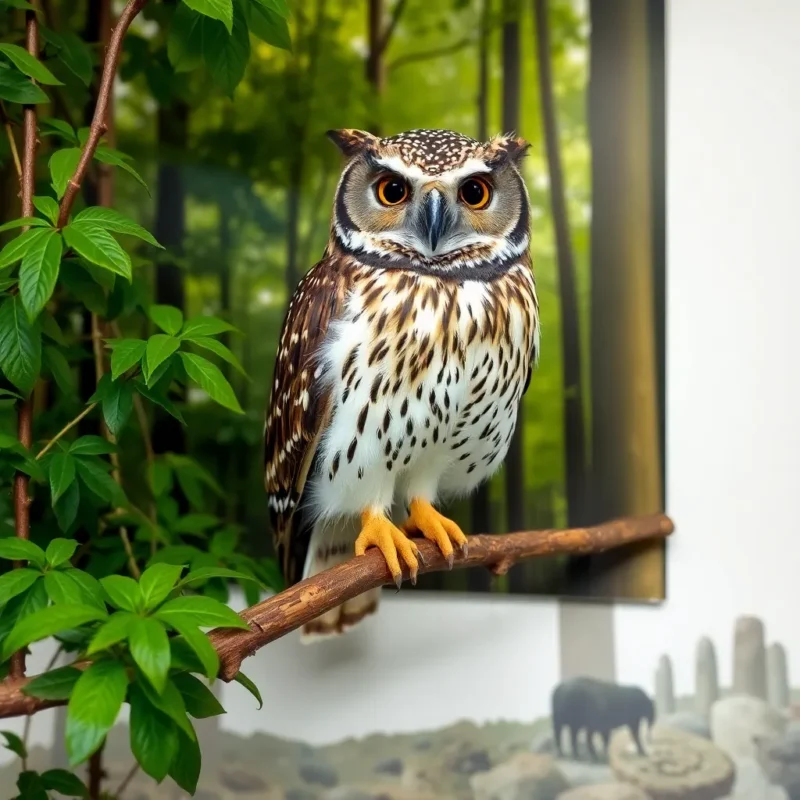Educational
Paws, Claws, and Effect: The Surprising Benefits of Taxidermy for Conservation
Taxidermy, often viewed as a relic of the past, has been rebranded as a vital tool in the fight against species extinction. By preserving specimens, taxidermists can help scientists study and understand the anatomy and behavior of endangered species, ultimately informing conservation efforts. For instance, the American Museum of Natural History has an extensive collection of taxidermied specimens that serve as a valuable resource for researchers and conservationists.
In addition to providing a window into the natural world, taxidermy also plays a crucial role in education and outreach. By creating lifelike mounts, taxidermists can help raise awareness about the plight of endangered species and inspire the next generation of conservationists. Furthermore, taxidermy can be used to recreate extinct species, serving as a poignant reminder of the importance of conservation efforts.
Moreover, taxidermy can aid in the development of conservation strategies by providing insights into the ecology and behavior of species. For example, studying the diet and habitat of a taxidermied specimen can inform conservation efforts aimed at protecting its natural habitat. This approach has been successfully employed in the conservation of species such as the California condor, which was once on the brink of extinction.
Education and Awareness
Taxidermy specimens have been used in educational settings for decades, providing a unique opportunity for people to get up close and personal with animals they may never encounter in the wild. According to the International Union for Conservation of Nature (IUCN), education and awareness are critical components of conservation efforts, and taxidermy can play a significant role in inspiring people to take action.
By presenting animals in a lifelike state, taxidermy can help to humanize the species and create an emotional connection with the viewer. This emotional connection can be a powerful motivator, inspiring people to learn more about the species and the threats they face. For example, a taxidermy specimen of an endangered species like the mountain gorilla can help to raise awareness about the importance of habitat conservation and the impact of human activities on their populations.
In addition to raising awareness about endangered species, taxidermy can also be used to teach people about the importance of conservation and the interconnectedness of ecosystems. By displaying taxidermy specimens in a naturalistic setting, educators can help to recreate the natural habitats of the animals and demonstrate the delicate balance of ecosystems. This can be a powerful tool for teaching people about the importance of preserving biodiversity and protecting the natural world.

Scientific Research and Data Collection
Taxidermy specimens have long been a valuable resource for scientists seeking to understand various aspects of animal biology. By examining preserved specimens, researchers can gain insights into animal behavior, anatomy, and ecology that might be difficult or impossible to obtain through live observations or experiments. For instance, taxidermy specimens can provide detailed information on the morphology of different species, which can inform studies on evolutionary relationships and adaptation to specific environments.
One of the key advantages of taxidermy specimens is that they can be studied repeatedly and in great detail, allowing researchers to gather a wealth of data on various aspects of animal biology. This is particularly useful for studying rare or endangered species, where live specimens may not be readily available for study. According to the American Museum of Natural History, taxidermy specimens have played a crucial role in the discovery and description of many new species (https://www.amnh.org/learn/taxidermy).
In addition to providing insights into animal biology, taxidermy specimens can also inform conservation efforts by shedding light on population dynamics, habitat requirements, and the impact of human activities on ecosystems. By analyzing the characteristics of preserved specimens, researchers can identify trends and patterns that may indicate changes in population sizes, habitat destruction, or other environmental stressors. This information can be used to develop effective conservation strategies and inform policy decisions.
Conservation Efforts and Species Preservation
The use of taxidermy in conservation efforts is a valuable tool in the fight against extinction. By creating highly realistic models of endangered species, taxidermists can help educate the public about the importance of conservation and inspire action to protect these animals and their habitats. According to the International Union for Conservation of Nature (IUCN), invasive species are one of the main drivers of biodiversity loss, and taxidermy can play a role in highlighting the impact of human activities on the environment.
Taxidermy can also aid in the development of species reintroduction programs by providing a lifelike representation of the species in question. This can help scientists and conservationists better understand the behavior and habitat requirements of the species, ultimately informing the reintroduction process. Furthermore, taxidermy models can be used in educational programs to teach people about the importance of conservation and the role they can play in protecting endangered species.
In addition to its role in education and research, taxidermy can also support habitat restoration efforts. By creating detailed models of ecosystems and habitats, taxidermists can help conservationists visualize and plan restoration projects. This can be particularly useful in cases where habitats have been degraded or destroyed, and restoration efforts are necessary to support the recovery of endangered species.

The Art of Taxidermy: A Conservation Tool
One of the most significant advantages of taxidermy in conservation is its ability to engage the public and inspire a sense of wonder and curiosity about the natural world. By creating lifelike specimens, taxidermists can help people connect emotionally with the animals they are trying to protect, fostering a deeper appreciation for the importance of conservation efforts. According to the International Union for Conservation of Nature (IUCN), education and awareness are critical components of successful conservation strategies, and taxidermy can play a vital role in this process.
In addition to its educational value, taxidermy can also provide valuable insights for researchers. By studying preserved specimens, scientists can gain a better understanding of animal anatomy, behavior, and ecology, which can inform conservation efforts. For example, taxidermy specimens can be used to study the impact of climate change on species distribution and behavior, as noted by the National Oceanic and Atmospheric Administration (NOAA).
Furthermore, taxidermy can help support conservation efforts by providing a unique opportunity for collaboration between artists, scientists, and conservationists. By combining their expertise, these professionals can create engaging and informative exhibits that raise awareness about the importance of conservation and inspire action. As the World Wildlife Fund (WWF) notes, collaboration and community engagement are essential for achieving conservation goals.
Ultimately, the benefits of taxidermy for conservation are undeniable. By inspiring a new generation of conservationists, providing valuable insights for researchers, and supporting conservation efforts, taxidermy can play a critical role in the fight against extinction. As we continue to face the challenges of biodiversity loss, it is essential that we harness the power of taxidermy to protect our planet’s precious wildlife.
Conclusion: Preserving Life Through Taxidermy
One of the most significant advantages of taxidermy in conservation efforts is its ability to aid in species identification and education. By creating lifelike replicas of endangered species, taxidermists can help researchers and scientists study and understand the physical characteristics of these animals, ultimately informing conservation strategies. For instance, the American Museum of Natural History has an extensive collection of taxidermied specimens that serve as a valuable resource for scientists and students alike.
Taxidermy also plays a crucial role in raising awareness about the importance of conservation. By creating visually striking and realistic displays, taxidermists can help captivate the public’s attention and inspire a sense of wonder and appreciation for the natural world. This, in turn, can motivate individuals to take action and make a positive impact on the environment. Many zoos and wildlife organizations, such as the World Wildlife Fund, have successfully utilized taxidermy in their educational programs and exhibits.
In addition, taxidermy can serve as a valuable tool in the fight against wildlife trafficking. By creating fake specimens that are nearly indistinguishable from real ones, taxidermists can help law enforcement agencies and conservation organizations combat the illegal wildlife trade. This innovative approach has already shown promise in reducing the demand for endangered species and disrupting criminal networks.

